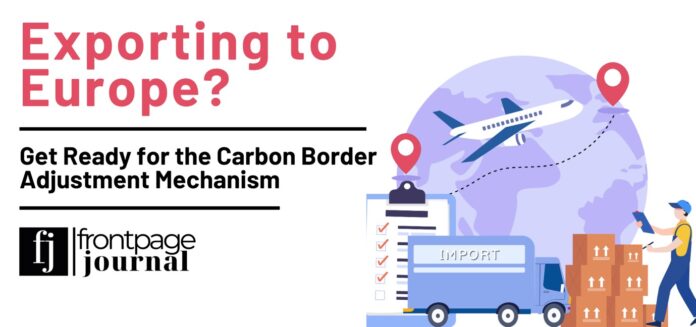Sri Lankan exporters particularly in manufacturing, agriculture, and value-added processing are standing at a strategic crossroads. The European Union has officially begun the transition to its Carbon Border Adjustment Mechanism (CBAM), a policy shift that will have global implications for trade, compliance, and competitiveness. CBAM represents a structural change in how carbon-intensive imports are taxed and reported, and for Sri Lankan businesses, especially those reliant on EU markets, the message is clear, carbon will now carry a cost. But for those prepared to adapt, it could also open new opportunities particularly in the wake of the United Kingdom’s recent decision to eliminate import tariffs on a wide range of Sri Lankan goods.
CBAM is the EU’s mechanism for ensuring that imported products are subject to the same carbon pricing as those produced within Europe. Initially targeting sectors such as iron and steel, aluminium, cement, fertilizers, electricity, and hydrogen, the regulation is expected to expand over time. From 2026 onward, exporters in covered sectors will be required to report the embedded carbon emissions of their products and pay a carbon charge if those emissions exceed EU benchmarks. The rationale is simple, to prevent carbon leakage and maintain a level playing field for EU producers who already operate under strict environmental regulations.
For Sri Lanka’s export economy, which relies heavily on apparel, rubber, tea, ceramics, and processed agricultural products, this new regulatory framework must be treated as an urgent strategic consideration. While many of these products are not yet subject to CBAM, the global momentum toward carbon accountability is undeniable. France and Germany are already pushing for broader product coverage, and the EU’s Green Deal framework aims for net-zero imports by 2050. In short, the cost of carbon is becoming a new trade barrier.
At the same time, the United Kingdom has introduced a separate but equally significant trade policy shift by removing tariffs on a wide range of products from Sri Lanka under its Developing Countries Trading Scheme (DCTS). This gives Sri Lankan exporters a competitive edge in price-sensitive segments if they can meet quality, traceability, and increasingly, environmental compliance expectations. This tariff elimination is a gift, but it is conditional. UK buyers are under growing pressure from ESG-conscious investors and consumers, and they are now assessing supplier sustainability practices more rigorously than ever.
This dual shift, the EU’s carbon tax framework and the UK’s liberalized tariff access, demands a recalibration of how Sri Lankan exporters think about competitiveness. Price, quality, and delivery are no longer sufficient. Carbon footprint, energy source, production transparency, and environmental reporting are becoming non-negotiable.
For C-suite leaders, this is not an operational tweak. It is a strategic inflection point. The companies that act now to measure, reduce, and report their carbon emissions will gain a long-term market advantage. Those that ignore these developments risk being locked out of two of Sri Lanka’s most important export destinations.
The strategic response must begin with carbon measurement. Manufacturers need to conduct detailed audits of their energy use, raw materials sourcing, and process emissions. This includes direct emissions (Scope 1), indirect emissions from purchased energy (Scope 2), and increasingly, value chain emissions (Scope 3). Tools like the GHG Protocol, ISO 14064, and sector-specific frameworks provide a starting point, but the process must be embedded in business planning, not left to a sustainability report addendum.
Next comes investment in cleaner production. This could include transitioning to renewable energy, upgrading machinery for energy efficiency, improving waste management, and rethinking product design to reduce lifecycle emissions. These upgrades are not just compliance actions. They unlock operational savings, enhance product value, and position firms as preferred suppliers for global retailers who are rapidly decarbonizing their supply chains.
Reporting infrastructure will also become critical. Exporters must prepare for a world where digital traceability, product-level emissions declarations, and third-party verification are standard. Sri Lanka’s private sector must collaborate with government agencies, chambers, and certification bodies to streamline access to reporting tools, train compliance officers, and build local audit capacity. A national platform to support exporters in low-carbon reporting, much like those emerging in Vietnam and Bangladesh, could make a decisive difference.
Policymakers too must support this shift. Incentives for renewable energy adoption, green financing, export-linked ESG certification, and digital infrastructure are no longer optional, they are essential competitiveness tools. Trade facilitation should align with EU and UK requirements so that Sri Lankan exporters can qualify for preferential market access not just on price, but on principles.
There is a deeper opportunity embedded in all this. Sri Lanka can begin to reposition itself as a sustainable sourcing hub for low-carbon, ethically produced goods. This is especially viable in sectors where the country already has strengths, organic agriculture, ethical apparel, and fair-trade tea. CBAM and the UK’s tariff exemptions create the conditions for this transformation. What is needed now is alignment, leadership, and speed.
In the coming decade, the carbon intensity of exports will be as critical as cost and quality. The companies that will lead Sri Lanka’s export future are not the ones with the lowest prices but those with the cleanest footprints and the clearest reporting. The world is not waiting. Europe has already moved, and the UK is rewarding low-emission value chains with preferential access. The next move is ours.




